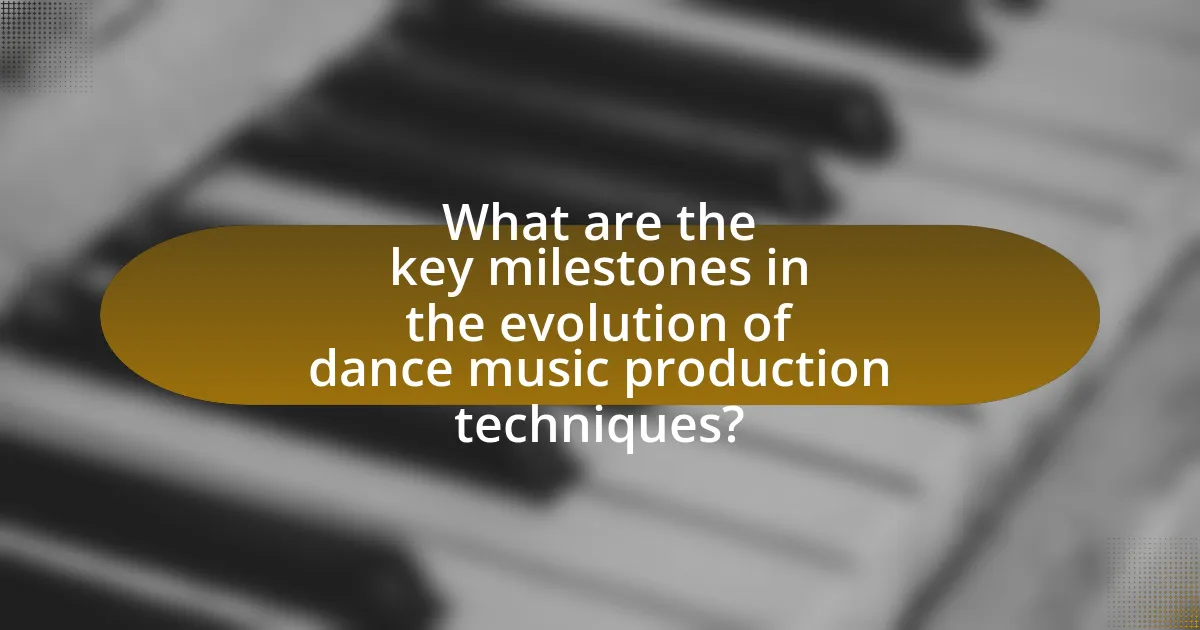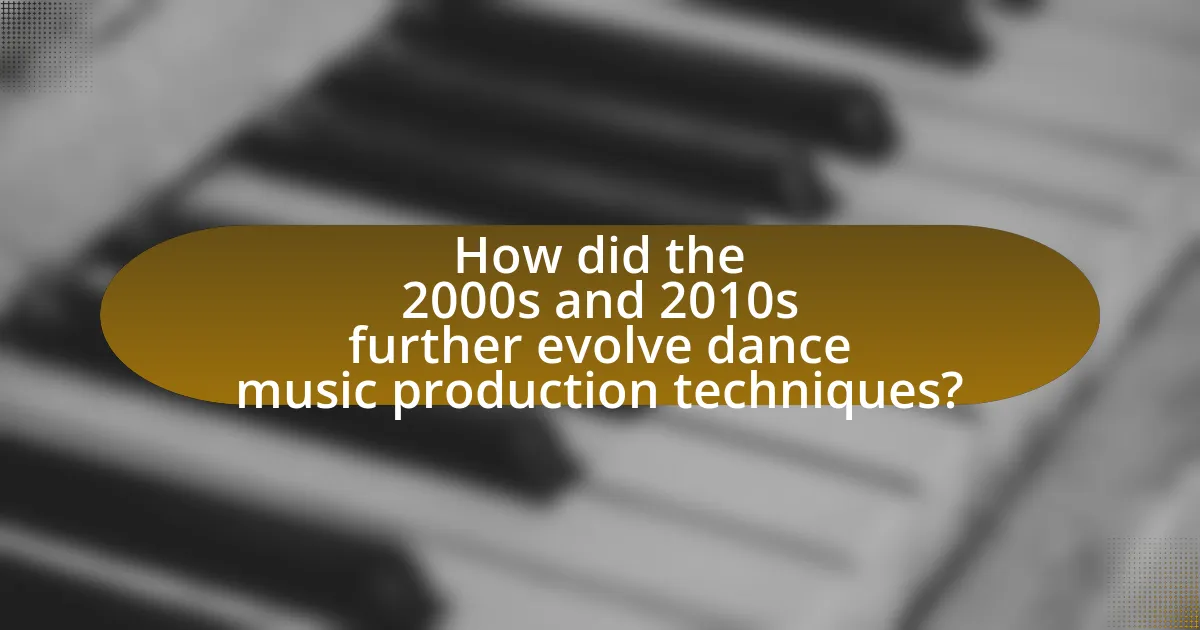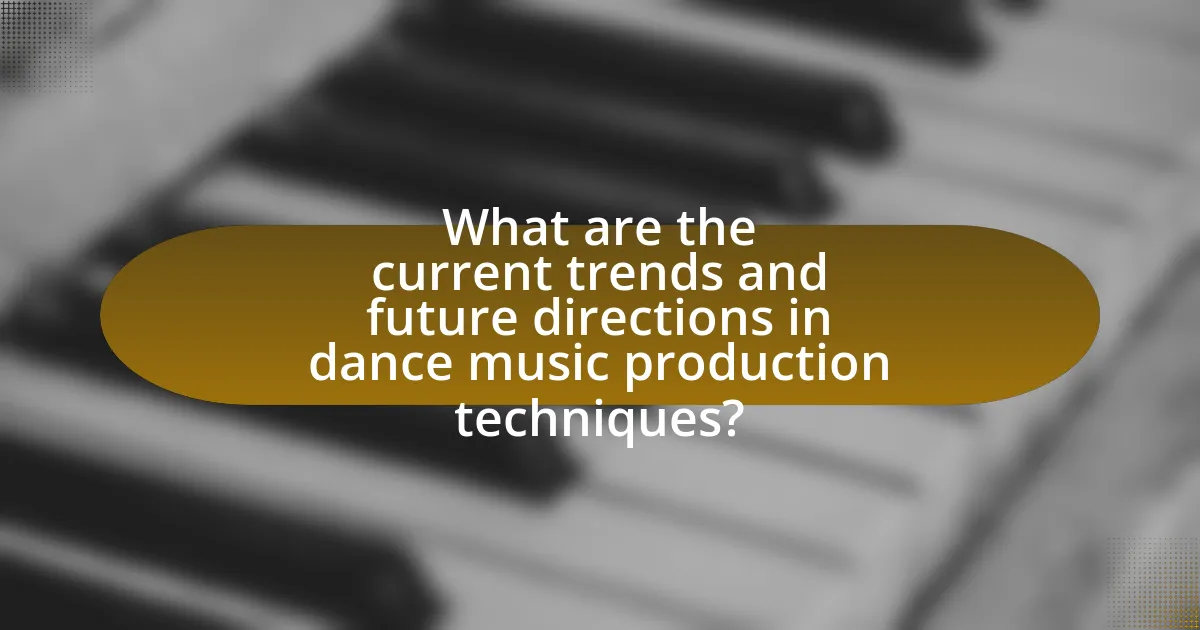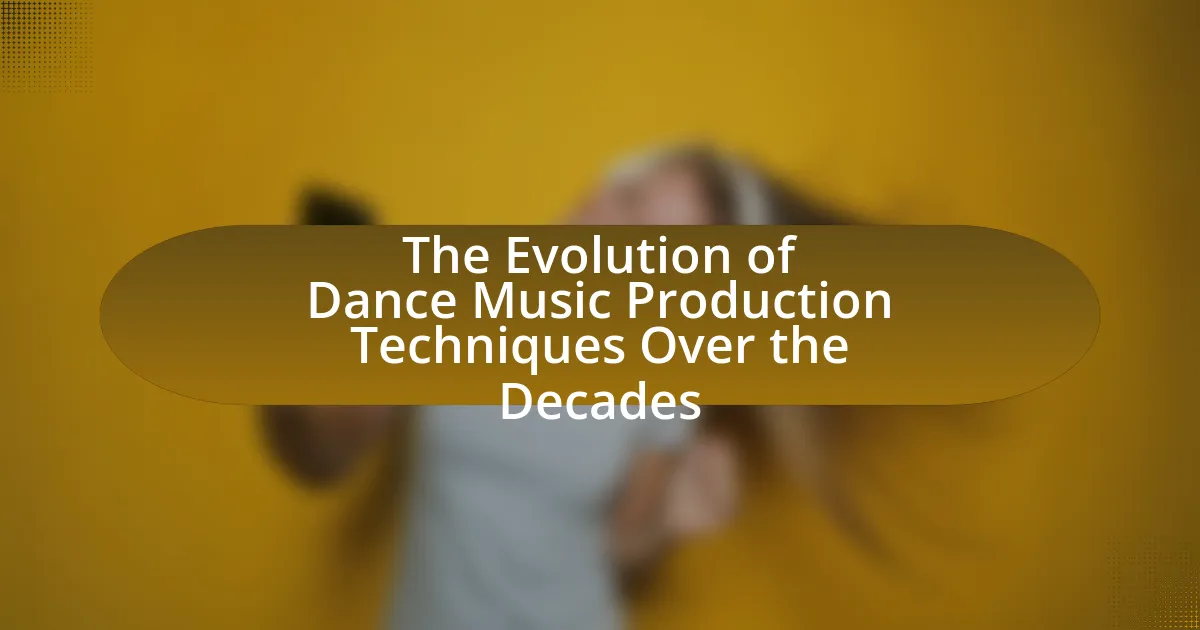The article examines the evolution of dance music production techniques from the 1970s to the present, highlighting key milestones such as the introduction of synthesizers, MIDI technology, digital audio workstations (DAWs), and software plugins. It details how technological advancements in each decade influenced production methods, including the impact of synthesizers and drum machines in the 1970s, the rise of sampling and DAWs in the 1990s, and the proliferation of VST plugins in the 2000s and 2010s. The discussion also covers current trends like artificial intelligence and immersive audio technologies, as well as best practices for producers to remain relevant in an evolving landscape.

What are the key milestones in the evolution of dance music production techniques?
The key milestones in the evolution of dance music production techniques include the introduction of synthesizers in the 1970s, the development of MIDI in the early 1980s, the rise of digital audio workstations (DAWs) in the 1990s, and the proliferation of software plugins in the 2000s. Synthesizers, such as the Moog and Roland TR-808, allowed producers to create new sounds and rhythms, fundamentally changing music production. The introduction of MIDI enabled electronic instruments to communicate, streamlining the production process. The emergence of DAWs like Pro Tools and Ableton Live revolutionized how music was recorded and edited, making production more accessible. Finally, the widespread availability of software plugins expanded creative possibilities, allowing for intricate sound design and effects processing. These milestones collectively transformed dance music production, making it more innovative and diverse.
How did the technological advancements in the 1970s influence dance music production?
Technological advancements in the 1970s significantly influenced dance music production by introducing synthesizers, drum machines, and multitrack recording techniques. The development of affordable synthesizers, such as the Moog and ARP Odyssey, allowed producers to create new sounds and textures that became foundational in dance music. Additionally, the introduction of drum machines, like the Roland TR-77, enabled artists to produce consistent and programmable beats, which were essential for the emerging disco and electronic genres. Multitrack recording technology allowed for more complex arrangements and layering of sounds, facilitating the production of richer and more dynamic tracks. These innovations collectively transformed the landscape of dance music, leading to the creation of iconic tracks that defined the era.
What role did synthesizers play in shaping the sound of dance music in the 1970s?
Synthesizers were pivotal in shaping the sound of dance music in the 1970s by introducing new textures and electronic sounds that transformed musical compositions. The emergence of synthesizers, such as the Moog and ARP Odyssey, allowed artists to create innovative sounds that were previously unattainable with traditional instruments. This technological advancement led to the development of genres like disco and electronic dance music, characterized by repetitive beats and synthesized melodies. Notably, tracks like Donna Summer’s “I Feel Love,” produced by Giorgio Moroder in 1977, exemplified the synthesizer’s impact, featuring a continuous electronic beat and lush synthesizer arrangements that defined the era’s dance music landscape.
How did the introduction of drum machines impact production techniques during this era?
The introduction of drum machines revolutionized production techniques by enabling musicians to create complex rhythms and beats with precision and consistency. This technological advancement allowed producers to experiment with new sounds and styles, leading to the emergence of genres like electronic dance music in the late 1970s and 1980s. Drum machines, such as the Roland TR-808 and TR-909, became iconic tools in studios, providing a reliable and programmable alternative to live drumming. Their ability to layer sounds and manipulate tempo facilitated innovative arrangements and production methods, significantly shaping the sound of contemporary music.
What changes occurred in the 1980s that transformed dance music production?
The 1980s saw significant technological advancements that transformed dance music production, primarily through the introduction of affordable synthesizers, drum machines, and digital sampling. The widespread availability of instruments like the Roland TR-808 drum machine and the Yamaha DX7 synthesizer allowed producers to create new sounds and rhythms that defined the era. Additionally, the advent of MIDI (Musical Instrument Digital Interface) in 1983 enabled different electronic instruments to communicate and synchronize, streamlining the production process. These innovations led to the emergence of genres such as house and techno, which relied heavily on electronic production techniques, fundamentally changing the landscape of dance music.
How did the rise of digital audio workstations (DAWs) affect music production in the 1980s?
The rise of digital audio workstations (DAWs) in the 1980s revolutionized music production by enabling musicians to record, edit, and mix audio digitally, which significantly increased efficiency and creativity. DAWs allowed for non-linear editing, meaning producers could manipulate audio tracks without the constraints of traditional tape-based systems, leading to more complex arrangements and sound experimentation. The introduction of software like Pro Tools in 1989 exemplified this shift, providing tools for multi-track recording and advanced editing capabilities that were previously unavailable. This technological advancement democratized music production, allowing independent artists to produce high-quality recordings without the need for expensive studio time, thus reshaping the music industry landscape.
What influence did the emergence of house and techno genres have on production techniques?
The emergence of house and techno genres significantly influenced production techniques by popularizing the use of drum machines, synthesizers, and sequencers. These genres, originating in the 1980s, emphasized electronic instrumentation, leading to the widespread adoption of tools like the Roland TR-808 and TR-909 drum machines, which became staples in dance music production. Additionally, the use of MIDI technology allowed for more precise control over musical elements, enabling producers to create complex arrangements and layered sounds. This shift towards electronic production techniques not only transformed the sound of dance music but also laid the groundwork for future genres, as evidenced by the proliferation of digital audio workstations (DAWs) in the 1990s and beyond, which further democratized music production.
What were the defining characteristics of dance music production in the 1990s?
Dance music production in the 1990s was characterized by the widespread use of digital audio workstations (DAWs), the incorporation of sampling technology, and the emergence of various subgenres such as techno, house, and trance. The introduction of software like Pro Tools and hardware synthesizers allowed producers to create complex arrangements and manipulate sounds with unprecedented precision. Additionally, the use of samples from disco, funk, and hip-hop tracks became a hallmark of the era, enabling artists to blend different musical styles. The 1990s also saw the rise of the rave culture, which influenced the production techniques and aesthetics of dance music, leading to a focus on high-energy beats and immersive soundscapes.
How did sampling technology revolutionize dance music production in the 1990s?
Sampling technology revolutionized dance music production in the 1990s by enabling artists to incorporate pre-recorded sounds and musical snippets into their tracks, significantly enhancing creativity and diversity in music. This innovation allowed producers to manipulate and layer samples from various genres, leading to the emergence of new styles such as house, techno, and hip-hop. The widespread availability of affordable samplers, like the Akai MPC series, facilitated this shift, allowing both amateur and professional musicians to experiment with sound in unprecedented ways. The impact of sampling is evident in iconic tracks from that era, such as The Prodigy’s “Firestarter” and Daft Punk’s “Around the World,” which utilized samples to create unique sonic landscapes that defined the decade.
What impact did the internet have on the distribution and production of dance music during this decade?
The internet significantly transformed the distribution and production of dance music during this decade by enabling widespread access to music and democratizing production tools. Digital platforms like SoundCloud, Bandcamp, and Spotify allowed independent artists to distribute their music globally without traditional gatekeepers, leading to a surge in diverse sounds and styles. Additionally, software such as Ableton Live and FL Studio became more accessible, allowing aspiring producers to create high-quality tracks from home, which contributed to the rapid evolution of dance music genres. According to a 2020 report by the International Federation of the Phonographic Industry, streaming accounted for over 80% of global music revenue, highlighting the internet’s pivotal role in reshaping how dance music is consumed and produced.

How did the 2000s and 2010s further evolve dance music production techniques?
The 2000s and 2010s significantly advanced dance music production techniques through the widespread adoption of digital audio workstations (DAWs) and the integration of software synthesizers. The introduction of DAWs like Ableton Live and FL Studio allowed producers to manipulate audio with unprecedented flexibility, enabling complex arrangements and real-time performance capabilities. Additionally, the rise of VST plugins expanded sound design possibilities, allowing for intricate layering and effects processing.
The use of MIDI technology became more prevalent, facilitating precise control over virtual instruments and enhancing the ability to create intricate compositions. Furthermore, the democratization of music production tools led to a surge in home studios, making it easier for aspiring producers to create high-quality tracks without the need for expensive studio time. This shift contributed to the diversification of dance music genres, as producers experimented with new sounds and styles, ultimately shaping the landscape of modern electronic music.
What innovations in software and hardware emerged in the 2000s for dance music producers?
In the 2000s, significant innovations in software and hardware for dance music producers included the rise of digital audio workstations (DAWs) like Ableton Live and FL Studio, which revolutionized music production with user-friendly interfaces and powerful features. These DAWs enabled real-time audio manipulation, loop-based composition, and seamless integration with MIDI controllers, enhancing creativity and workflow efficiency. Additionally, hardware advancements such as MIDI controllers and synthesizers, including the Novation Launchpad and Korg’s microKORG, provided producers with tactile control and expressive capabilities, further enriching the production process. The introduction of VST plugins also allowed for an expanded palette of sounds and effects, enabling producers to create more complex and polished tracks.
How did the proliferation of VST plugins change the landscape of dance music production?
The proliferation of VST plugins significantly democratized dance music production by providing accessible, high-quality sound design tools to a broader range of producers. This accessibility allowed both amateur and professional musicians to create complex sounds and arrangements without the need for expensive hardware. For instance, the introduction of popular VST plugins like Serum and Massive enabled producers to design intricate synth sounds and manipulate audio in ways that were previously limited to high-end studios. As a result, the landscape of dance music production shifted towards a more inclusive environment, fostering innovation and creativity across various sub-genres. The rise of online communities and tutorials further supported this shift, allowing producers to share techniques and collaborate globally, thus accelerating the evolution of dance music styles.
What role did online collaboration play in the production of dance music during this period?
Online collaboration significantly enhanced the production of dance music during this period by enabling artists from diverse geographical locations to work together seamlessly. This collaborative approach facilitated the sharing of ideas, techniques, and resources, leading to innovative sounds and styles that might not have emerged in isolated environments. For instance, platforms like SoundCloud and Splice allowed producers to share their work and collaborate in real-time, resulting in a surge of creativity and cross-genre experimentation. The accessibility of digital audio workstations (DAWs) and online tutorials further democratized music production, allowing aspiring producers to learn from established artists and contribute to the dance music scene.
How did the rise of electronic dance music (EDM) in the 2010s influence production techniques?
The rise of electronic dance music (EDM) in the 2010s significantly influenced production techniques by popularizing the use of digital audio workstations (DAWs) and enhancing accessibility to music production tools. As EDM gained mainstream popularity, software like Ableton Live and FL Studio became essential for producers, allowing for intricate layering, sampling, and real-time manipulation of sounds. This shift led to a democratization of music production, where aspiring artists could create high-quality tracks from home studios without the need for expensive equipment. Additionally, the emphasis on drop-centric structures and sound design in EDM encouraged producers to experiment with synthesis and effects processing, resulting in innovative soundscapes and production styles that became hallmarks of the genre.
What production techniques became popular with the mainstream success of EDM artists?
The mainstream success of EDM artists popularized several production techniques, including the use of sidechain compression, sampling, and digital audio workstations (DAWs). Sidechain compression became a hallmark of EDM, allowing for the characteristic “pumping” sound that enhances the rhythmic elements of tracks. Sampling, particularly from various genres, enabled artists to create unique soundscapes and hooks, while DAWs like Ableton Live and FL Studio provided accessible platforms for both novice and professional producers to craft intricate compositions. These techniques contributed to the genre’s distinct sound and widespread appeal, as evidenced by the rapid growth of EDM festivals and chart-topping hits in the 2010s.
How did social media platforms impact the way dance music is produced and marketed?
Social media platforms significantly transformed the production and marketing of dance music by enabling direct artist-to-fan engagement and democratizing access to music distribution. Artists can now share their work instantly with a global audience through platforms like Instagram, TikTok, and SoundCloud, allowing for real-time feedback and collaboration. This shift has led to the rise of viral trends, where snippets of tracks can gain popularity quickly, influencing production styles and marketing strategies. For instance, TikTok’s algorithm has propelled many dance tracks to mainstream success, as seen with songs like “Savage Love” by Jawsh 685 and Jason Derulo, which gained traction through user-generated content. Additionally, social media analytics provide artists and labels with valuable insights into audience preferences, enabling targeted marketing campaigns that enhance reach and engagement.

What are the current trends and future directions in dance music production techniques?
Current trends in dance music production techniques include the increased use of artificial intelligence for sound design and composition, as well as the integration of immersive audio technologies like Dolby Atmos. Producers are leveraging AI tools to generate melodies and harmonies, streamlining the creative process. Additionally, the rise of virtual reality and augmented reality experiences is shaping future directions, allowing artists to create interactive performances that engage audiences in new ways. The growing popularity of modular synthesis and hardware-based production is also notable, as artists seek unique sounds and tactile experiences. These trends reflect a shift towards innovation and experimentation in the dance music landscape.
How are emerging technologies shaping the future of dance music production?
Emerging technologies are revolutionizing dance music production by enhancing creativity, accessibility, and efficiency. Innovations such as artificial intelligence (AI) and machine learning algorithms enable producers to generate unique sounds and automate repetitive tasks, allowing for more focus on artistic expression. Additionally, advancements in digital audio workstations (DAWs) and virtual instruments provide producers with a vast array of tools and sounds that were previously unavailable, fostering experimentation and innovation. For instance, AI-driven software like Amper Music and AIVA can compose music autonomously, demonstrating the potential of technology to augment human creativity. Furthermore, the rise of cloud-based collaboration tools facilitates remote teamwork among artists, breaking geographical barriers and expanding the global reach of dance music production.
What role does artificial intelligence play in modern music production?
Artificial intelligence significantly enhances modern music production by automating tasks, generating new sounds, and assisting in composition. AI algorithms analyze vast amounts of musical data to identify patterns, enabling producers to create unique compositions and soundscapes efficiently. For instance, tools like OpenAI’s MuseNet and Google’s Magenta utilize deep learning to compose music across various genres, demonstrating AI’s capability to innovate within the creative process. Additionally, AI-driven software can assist in mixing and mastering tracks, optimizing audio quality by learning from professional standards. This integration of AI not only streamlines production workflows but also expands the creative possibilities for artists in the evolving landscape of dance music.
How are virtual reality and augmented reality influencing the experience of dance music production?
Virtual reality (VR) and augmented reality (AR) are significantly enhancing the experience of dance music production by providing immersive environments for creativity and collaboration. These technologies allow producers to visualize sound in three-dimensional spaces, enabling them to manipulate audio elements in a more intuitive manner. For instance, VR platforms like Oculus Medium enable users to create and edit music in a virtual studio, where they can interact with sound waves and instruments as if they were physical objects. Additionally, AR applications can overlay digital soundscapes onto real-world environments, facilitating unique live performances and interactive experiences. This integration of VR and AR into dance music production not only fosters innovation but also expands the possibilities for audience engagement, as seen in events like the virtual festival “Tomorrowland Around the World,” which attracted over 1 million attendees in 2020, showcasing the potential of these technologies in reshaping the music landscape.
What best practices should producers follow to stay relevant in the evolving dance music landscape?
Producers should prioritize continuous learning and adaptation to stay relevant in the evolving dance music landscape. This involves regularly updating their skills through online courses, workshops, and tutorials that focus on new production techniques and software. Additionally, engaging with current trends by analyzing popular tracks and collaborating with other artists can provide insights into what resonates with audiences.
Moreover, leveraging social media platforms for promotion and audience engagement is crucial, as statistics show that 70% of music consumers discover new music through social media. By actively participating in online communities and sharing their work, producers can enhance their visibility and connect with fans.
Finally, experimenting with diverse genres and incorporating innovative sounds can help producers differentiate themselves in a saturated market, as the dance music scene is increasingly blending various styles. This approach not only keeps their music fresh but also appeals to a broader audience.
How can producers effectively incorporate new technologies into their workflow?
Producers can effectively incorporate new technologies into their workflow by adopting digital audio workstations (DAWs) and utilizing software plugins that enhance sound design and production efficiency. The integration of DAWs, such as Ableton Live or FL Studio, allows producers to streamline their creative processes, enabling real-time editing and manipulation of audio tracks. Additionally, the use of virtual instruments and effects plugins can expand the sonic palette available to producers, facilitating innovative sound creation. Research indicates that the adoption of technology in music production has led to increased productivity and creativity, as evidenced by a study published in the Journal of Music Technology and Education, which highlights how digital tools have transformed traditional music-making practices.
What strategies can be employed to adapt to changing audience preferences in dance music?
To adapt to changing audience preferences in dance music, producers can implement strategies such as continuous market research, collaboration with emerging artists, and leveraging data analytics. Continuous market research allows producers to identify trends and shifts in listener tastes, ensuring that their music remains relevant. Collaborating with emerging artists can introduce fresh sounds and perspectives, appealing to diverse audience segments. Additionally, leveraging data analytics from streaming platforms provides insights into listener behavior, enabling producers to tailor their music to meet evolving preferences. These strategies are supported by the fact that the dance music industry has seen significant shifts in popular genres and styles, as evidenced by the rise of sub-genres like future bass and lo-fi house, which have gained traction through audience engagement and feedback.
